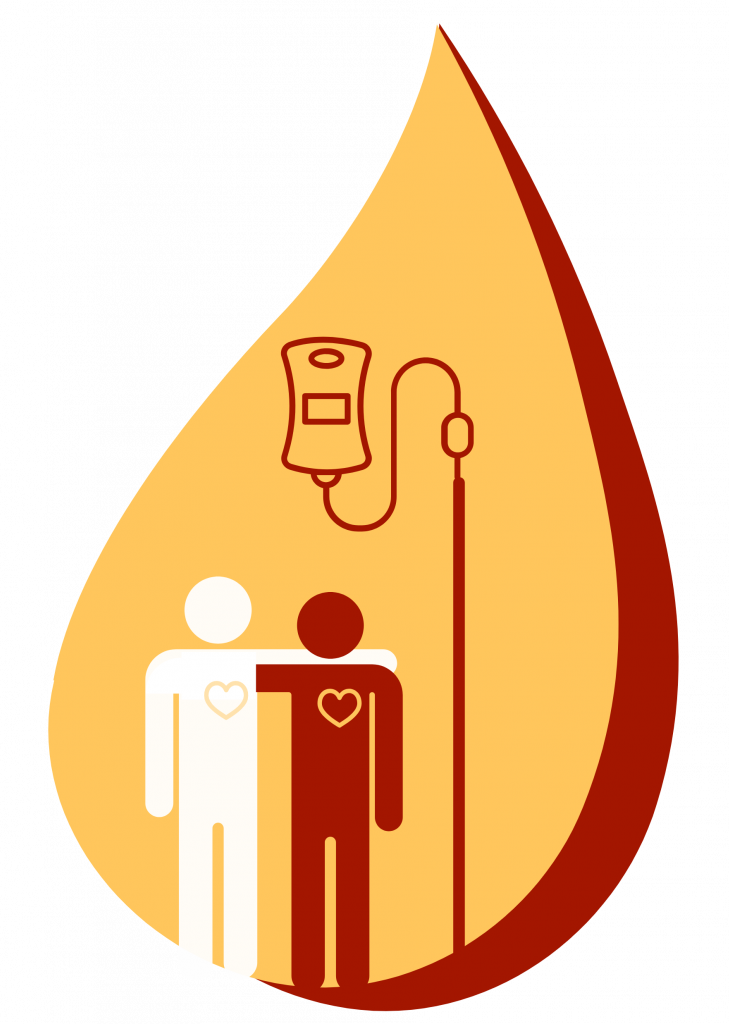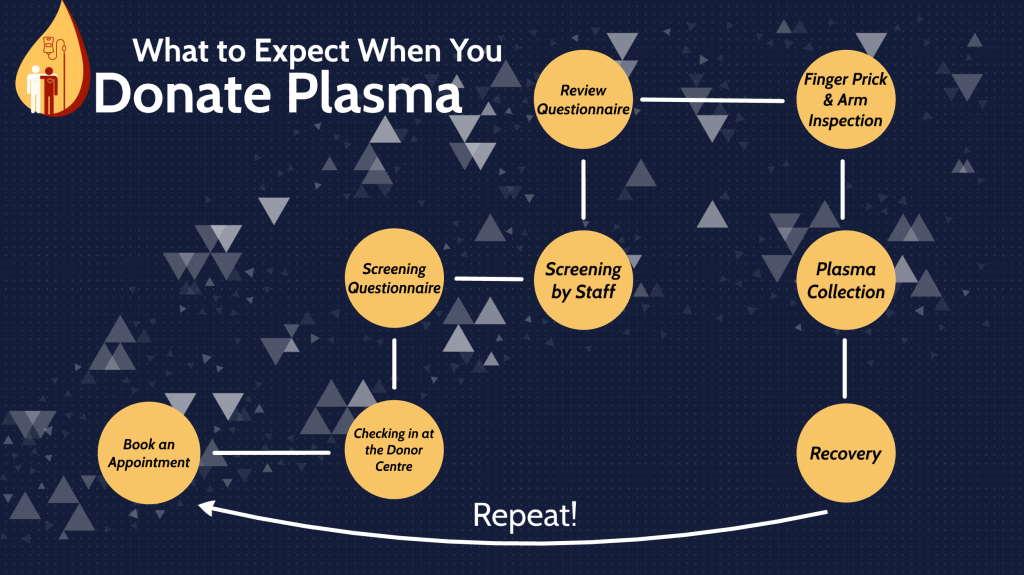The Plasma Donation Process
Thinking about donation may bring up some painful feelings. YOU ARE NOT ALONE. The 2SGBTQ+ communities have had a long and painful history with Canadian Blood Services. Find support resources here.
What Can I Expect When Donating Plasma?
Click on the image below to do a walk-through of the donation process.
8 Steps: From Booking an Appointment to Post-Donation Recovery
(1) Book an Appointment
You can book an appointment:
- Online at https://myaccount.blood.ca/
- By calling 1-888-2-DONATE (1-888-236-6283)
First Time Donors
If you’re booking online, you’ll need to create an account, providing some basic info, like your name, date of birth, and email.
You can check your eligibility by clicking the “Am I Eligible?” link on blood.ca.
Returning Donors
Simply make an appointment as usual!
You will need to complete a screening questionnaire either at home or at the donor centre.
Since you have already donated, you can fill out a shorter screening questionnaire.
(2) Check in at the Donor Centre
Covid screening: Donors are no longer screened for Covid-19 when they arrive at the Donor Centre or have their temperature taken. However, anyone who has had a Covid-19 infection must wait 10 days from when symptoms started or 10 days after a positive test result if asymptomatic to be eligible to donate.
Currently, you are not required to wear a mask in the Donor Centre, but you can if you wish.
First Time Donors
The staff at the front desk will check you in for your appointment.
They will give you a pamphlet that you have to read. It has some basic information about what will happen during donation and possible side effects or reactions.
Donor File is Created
The staff at the desk will confirm some of your information and will ask to see a piece of government-issued identification.
Returning Donors
First, you’ll check in. All donors have to read the donor pamphlet every time they donate, so you’ll be asked to do this at every appointment.
(3) Fill Out Screening Questionnaire
All donors have to fill out a screening questionnaire.
If you’re a returning donor, you had the option of filling it out online before your appointment.
If you’re a new donor or didn’t fill it out in advance, you’ll use the barcode that the front desk staff gave you to go to a private kiosk and fill out the questionnaire. (Here’s a link to the questionnaire: https://www.blood.ca/en/blood/donating-blood/donor-questionnaire)
Once you’re done, you wait until a screening staff member comes to finish the screening process.
(4) Screening by Staff
A screening staff member* will complete the screening process.
They will confirm that you have read and understood the donor pamphlet that you were given.
They’ll also ask to verify your identification.
Height and Weight
If this is your first visit, the staff will weigh and measure you.
If you are a returning donor, the nurse will ask if you have lost more than 10 pounds (about 4.5 kg).
There is a minimum height and weight needed to safely donate plasma; if you don’t meet the minimum, you won’t be able to donate.
Canadian Blood Services has a chart on their website where you can check minimum requirements (click on weight at the bottom of the list).
*Note that screening staff are usually registered nurses or other health care professionals who are ethically and professionally bound to keep all of your health information confidential.
(5) Staff Reviews Questionnaire
The screening staff member will go through the answers you gave on the questionnaire. They may need more details about some of your answers and will ask you follow-up questions.
There are no longer specific questions about having sex with a man in the past three months. Instead, the questions you will be asked are asked of all donors, regardless of gender.
- In the last three months, have you had a new sexual partner?
- In the last three months, have you had multiple sexual partners?
If the answer is “yes” to either question, then the screener (usually a registered nurse) who speaks to you privately in a screening booth, will ask this follow up question:
In the last three months, have you had anal sex with any partner?
Other Follow Up Questions
There are a lot of follow-up questions that you could be asked – too many to list here.
In some cases, you might not be able to donate, depending on donation rules. For example, if you have recently travelled to a country that has malaria or if you are taking certain medications.
In other cases, you may be able to donate based on the information you give to the follow-up questions.
Medical Enquiry
In rare situations, the screening staff will need to have a supervisor or a doctor ask further questions or perform an assessment to figure out whether it is safe to donate or not.
The screening staff at the Donor Centre must follow protocols (rules) outlined in their manuals. If there is a situation not covered by the manual, they will ask for a supervisor or a doctor to determine whether the person is allowed to donate.
→ Supervisor Follow-Up
The screening staff member may ask for a supervisor to continue follow-up questions. This is done during your appointment time.
→ Doctor Assessment
Needing an assessment by a doctor is very rare. The process can be complicated. Some basic information is provided here, but it is not exhaustive.
The screening staff may call a doctor who is on-call to see if it is possible to accept a donor. If screening staff can’t get in touch with the on-call doctor, or if the on-call doctor doesn’t have enough information to assess the donor, the donor will be asked for their regular doctor’s contact information. The on-call doctor or screening staff will write to the donor’s doctor to get more information. This additional information will help the on-call doctor decide whether it is safe for the donor to donate.
(6) Finger Prick & Arm Inspection
Finger Prick
The screening staff member pricks your finger with a small, sterile needle and takes a drop of blood. Then, they use a machine to check your hemoglobin (the part of your blood responsible for transporting oxygen).
This is done for your safety as a donor. If the numbers are not in a safe range, you are not able to donate.
The screening staff member uses these numbers, along with your sex, height, and weight, to figure out how much plasma you can donate.
Arm Inspection
Next, the screening staff member inspects your arm. They are checking for rashes, plaques, and vein issues that may make it difficult to donate. They are also looking for evidence of intravenous (IV) drug use.
If there are physical problems with your arms that prevent you from donating safely, you are unable to donate.
(7) Plasma Collection
A staff member (either a nurse or a phlebotomist) will hook you up to the machine that extracts your plasma (called an apheresis machine).
Monitoring During Collection
A staff member (usually a phlebotomist but sometimes a nurse) will keep an eye on you while you’re hooked up to the apheresis machine and having your blood taken.
The staff and other people who are donating will chat and socialize during this time.
It usually takes between 60 and 90 minutes to complete a donation.
(8) Recovery
When you are finished donating, you will be asked to sit in the refreshment area for about 5-10 minutes. New donors are asked to rest for longer. This is to make sure that you are feeling well after your donation.
You will be given a drink and a light snack, like a cookie.
(9) Repeat!
You can return to make another donation as often as every 6 days if you want!

